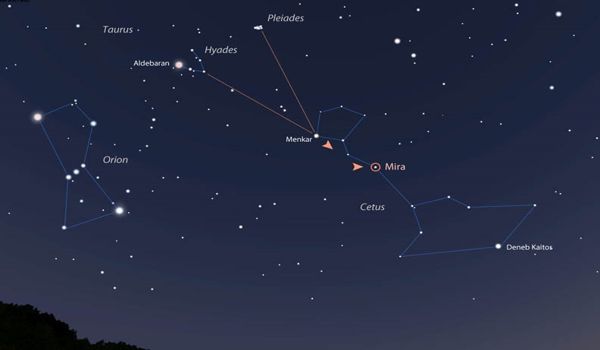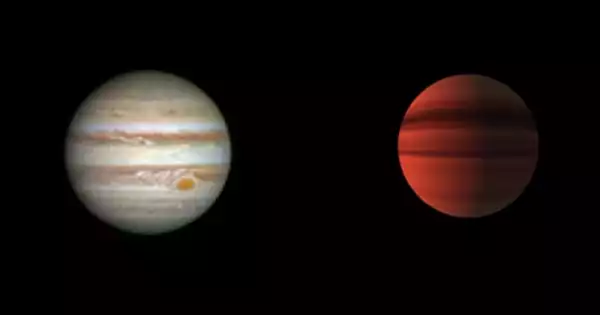Mira (designation Omicron Ceti) is a red giant star estimated to be 200–400 light-years from the Sun in the constellation Cetus. It lays 420 light-years away in the constellation Cetus the Whale. It is a binary star system with a white dwarf (Mira B, also known as VZ Ceti) star and a red giant (Mira A). Mira A is a pulsating variable star and was the first non-supernova variable star discovered, with the possible exception of Algol. It’s in an unremarkable patch of the night sky along the celestial equator, easily visible from the entire Earth, well to the west in our sky of the hard-to-miss constellation Orion the Hunter.
Scientists think Mira is 200-400 light years away in the constellation Cetus. The distance to Mira is uncertain; pre-Hipparcos estimates centered on 220 light-years; while Hipparcos data from the 2007 reduction suggest a distance of 299 light-years, with a margin of error of 11%.
Mira is an evolved red giant star located in the constellation Cetus. It is a pulsating variable that serves as a prototype for its own class of stars, known as the Mira variables.
Size
Mira has a diameter 332 to 541 times that of our sun.
Throughout the centuries, Mira has sometimes been as bright as 2nd magnitude, but it usually peaks at about magnitude +3.5. In other words, it might now be about as bright as it’ll get for this brightness peak. If Mira did not change the size, its diameter would be only 240 times larger than the Sun.
Mira is known to change size over time. It is visible to the unaided eye – except when it isn’t, which most of the time is. Other red giant stars that do the same are called Mira variables.

Lication
Mira is located in the constellation Cetus, known by the ancient Greeks as the monster that was about to attack Andromeda when the hero Perseus arrived just in time to destroy it.
Mira’s last brightness peak was in late October of 2019. Its next brightness peak is scheduled for late September, and indeed – according to recent observations from the American Association of Variable Star Observers (AAVSO) – Mira is now easily bright enough to be viewed with the eye alone.
As modern astronomers study the star, Mira continues to amaze. In 2007, observations by a satellite viewing in ultraviolet light discovered that Mira has a luminous tail of gas more than a dozen light-years long. Mira is the archetype of a class of stars known as long-period variables, red giants that steadily pulse over periods lasting about a year. This is the material that Mira has shed, leaving it behind as it speeds through the galaxy at some 80 miles per second (130 km per second) – very speedy for a star! The invisible trail spans about 2 degrees in the sky, about four times the diameter of a full moon. Once you locate the sea monster’s head, slip 12° to the southwest, where you’ll find a reddish star.
Information Source:















